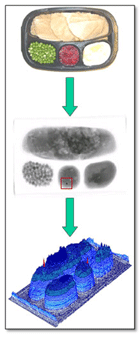Metal Detection
Metal Detectors are used to prevent damage to processing equipment and protect consumers from ingesting tramp metal.
Offering a relatively low cost solution for metal inspection they are capable of detecting the entire range of metals including magnetic metals such as iron & steel (Ferrous), conductive metal such as copper, aluminum, brass etc. (Nonferrous) and 300 series Nonmagnetic stainless steel which is commonly used in the Food industry.
Metal detector applications fall in two categories, “Dry” non conductive product inspection and “Wet” conductive product inspection.
Dry products are typically Biscuits, Cookies, Granola Bars & Solid Frozen Products.
Wet products are typically Meat, Cheese & Bread.
Dry product inspection applications yield the best sensitivity results because the detector doesn’t not have to deal with the conductive effects of the product.
In most cases the sensitivity of the metal detector is proportional to the aperture size. The smaller the aperture the greater the sensitivity.
Sensitivity to stainless steel is approximately 1.4 to 1.5 times the Ferrous sensitivity.
In Wet or conductive product inspection applications metal detectors can use a variety of techniques to compensate or minimize the conductive effects of the product. However since wet products in most cases have the same conductivity profile as Nonmagnetic stainless steel the ratio of Ferrous to Stainless increases to 2.0 or greater depending on amount of product being inspected.
Metal Detection Applications:
- Wash-down conveyor belt systems for packaged product inspection.
- Conveyor belt systems for packaged product inspection. (Up to 50 KG Bags)
- Conveyor belt systems for bulk product inspection.
- Conveyor belt systems for Ferrous in Foil metal detectors.
- In process gravity metal detectors for free flow dry products.
- Free fall slim line for scale/bagger applications.
- In process pipeline metal detectors for pumped liquids, slurry & meat.
- Tablet press metal detectors for capsules and tablets.
- Large aperture metal detectors for lumber/pulp & paper Industry
- Web surface units for textiles & paper
- Vent tube systems for plastic & glass bottles
Recommended Design Features:
- High Density Head Fill – Eliminates false positives caused by vibration - Head Fill does not absorb water
- High pressure wash-down chute liner
- High Frequency High Power Transmitter – Highest possible sensitivity to Nonmagnetic stainless steel
- Tuned input Coil – Highest possible detector performance- Greater resistance to electrical noise
- Highest Resolution Digital Electronics – Single pass product learn function
- Straight Forward and Simple to use Operator Controls
- Test Request Capability – Automatic recording of test results
- Ethernet Port for Data Logging & Networking
- Totally Modular Electronics – Ease of service
Advantages of Metal Detectors:
- Low cost investment VS X–Ray.
- Low cost of ownership. ( Solid state transmitter, no tubes to replace)
- Sensitivity comparable to X ray in many dry product applications
- Automatic record keeping - Networking
- Satisfies HACCP requirements
X-Ray Inspection
Used in a multitude of industries (Food, Pharma, Consumer Goods, etc.), an X-Ray inspection system will allow you to detect a multitude of quality defects such as:
- Contaminants (metallic and non-metallic)
- Check-Weighing
- Fill Level
- etc.




